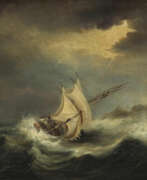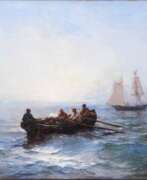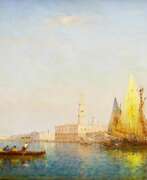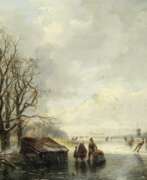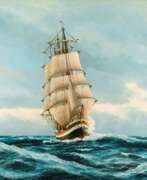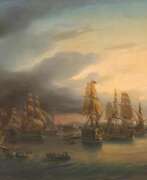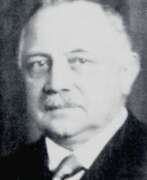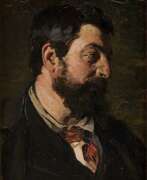Marine painters 19th century


Antonio De Simone was an Italian marine painter.
He created many paintings depicting various ships at sea: frigates, yachts, sailing ships and steamships, in the storm and with the sails down. De Simone also painted historical battle scenes, such as his famous painting - "Bombardment of Alexandria", which is in the Royal Greenwich Museums.


Ivan Konstantinovich Aivazovsky (Russian: Иван Константинович Айвазовский) was a Russian-Armenian painter, celebrated for his mastery in depicting seascapes. Born in 1817 in Feodosia, Crimea, Aivazovsky became one of the most renowned Russian artists of his time, with a career spanning over 60 years during which he created more than 6,000 paintings. His work is characterized by a profound understanding of the play of light on water, capturing the essence of the sea like no other artist of his era.
Aivazovsky's paintings stand out for their dramatic intensity and the emotional depth they evoke. He was particularly adept at illustrating the sea's many moods, from calm, serene waters to tumultuous storms. His ability to depict light, whether it be the tranquil glow of the moon on the water's surface or the fierce blaze of the sun setting over the ocean, was unparalleled. Among his most celebrated works are "The Ninth Wave" and "Among the Waves," both of which showcase his skill in portraying the sea's power and beauty. These masterpieces can be found in prestigious museums and galleries worldwide, including the State Russian Museum in Saint Petersburg and the Tretyakov Gallery in Moscow.
For collectors and experts in the realms of art and antiques, Aivazovsky's oeuvre represents a pinnacle of romantic landscape painting. His works are not only aesthetically magnificent but also embody a rich cultural and historical narrative, making them highly sought after in the art market. If you are passionate about the fusion of culture, art, and history embodied in painting, Ivan Konstantinovich Aivazovsky's works are a testament to the enduring allure of the sea and its many faces.
To stay informed about new product sales and auction events related to Ivan Konstantinovich Aivazovsky, we invite you to sign up for our updates. This subscription ensures you're always in the know about opportunities to add a piece of this legendary artist's legacy to your collection.


Gustav Adolf Amberger was a German painter and graphic artist. He lived in Rome for two years and learned the painting trade from Peter von Cornelius. One of his first works was the painting The Oceanides. Amberger worked as a designer in the ribbon factory founded by Philipp Trüdinger. Around 1870 he was the court painter to the Landgrave of Hesse. In Antwerp he was a pupil of Joseph van Lerius and made numerous copies, of which Les deux voies is the best known.


Peder Balke, née Peder Andersen, was a Norwegian landscape painter and marinist.
Balke is one of the most prominent representatives of Romantic painting in Northern Europe. After receiving his art education at the Royal Academy of Art in Stockholm, he made a great journey to the northernmost parts of Norway in 1832, which inspired him for the rest of his life. Throughout this long itinerary, the artist made sketches and sketches that later developed into large canvases. Some of these paintings were bought by the Swedish royal family, some went to the Palace of Versailles and the National Gallery of Oslo. Balke also traveled to Germany and Russia, and visited Paris and London.
Peder Balke mainly depicted Arctic landscapes - snowy cliffs and mountains, midnight sun and northern lights, a sea full of danger with ice. But this wild, pristine and powerful beauty of Norway in the artist's view is full of drama and perhaps in need of protection.
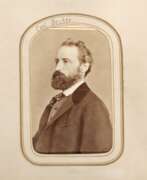

Carl Emil Rudolf Ludwig Becker was a German marine artist.
He was awarded gold medals at the International Art Exhibition of 1894, in Vienna, and the Große Berliner Kunstausstellung of 1896. Three years later, he was one of the co-founders of the Düsseldorfer Künstler-Vereinigung (artists' association). After the turn of the century, marine painting was heavily promoted by Kaiser Wilhelm II, who was attempting to make Germany a major sea power. As a result, the demand for Becker's paintings increased farther inland.


Thomas Birch was an English-born American portrait and marine painter.
He exhibited regularly at the Pennsylvania Academy of the Fine Arts for forty years, beginning in 1811, and managed the museum, 1812-1817. His work is collected at PAFA, the Library Company of Philadelphia, the Philadelphia Museum of Art, the Smithsonian American Art Museum, the U.S. Naval Academy, and the Museum of Fine Arts, Boston, among others. In 1833, he was elected into the National Academy of Design as an Honorary member.


Hans Bohrdt was a German marine painter and graphic artist. Bohrdt's journey into marine painting began after a visit to the Hamburg port at the age of 15, sparking a lifelong passion for the sea and maritime subjects. Unlike many artists of his time who had formal art education, Hans Bohrdt was largely self-taught, although he did attend the Academy of Fine Arts in Berlin for a period. His dissatisfaction with the conventional training led him to pursue a more hands-on approach to his art, focusing on seascapes and marine life.
Hans Bohrdt's work gained significant recognition during the Wilhelmine era, making him a celebrated figure in German marine painting, a genre that became particularly prominent after the unification of Germany in 1871. His close relationship with Kaiser Wilhelm II, who was an admirer and patron of his work, helped elevate Bohrdt's status further. Bohrdt's art was known for its technical skill, particularly in depicting the majesty of the sea and the vessels that traversed it. His pieces often featured German naval prowess and were used for both private collections and public display, contributing to national pride and naval propaganda, especially during World War I.
The legacy of Hans Bohrdt is marked by his ability to capture the spirit and grandeur of maritime life, making him a significant figure in the history of German art. Despite the challenges posed by the world wars, which led to the loss of many of his works including his best-known painting, "Der letzte Mann" ("The Last Man"), Bohrdt's art continues to be celebrated for its contribution to marine painting. In 1995, on the fiftieth anniversary of his death, a memorial exhibition was held, showcasing his contributions to the field and reaffirming his place as one of the last great marine painters.
For collectors and experts in art and antiques, Hans Bohrdt's work offers a unique glimpse into the development of marine painting in Germany, reflecting both the beauty of the maritime world and the historical context of his times. To stay informed about sales, auction events, and updates related to Hans Bohrdt's work, signing up for newsletters from galleries and auction houses specializing in maritime art and antiques is recommended. This ensures enthusiasts and collectors are well-informed about opportunities to acquire pieces by this distinguished artist.


Arthur Merric Boyd was an Australian painter. He and his wife Emma Minnie (née à Beckett) established a lifestyle of being artists which many generations followed to create the popular image of the Boyd family. Boyd travelled and painted a good deal on the continent of Europe, and returned to Australia about the end of 1893, where he lived mostly in Sandringham and other suburbs of Melbourne for the rest of his life. He occasionally sent good work to the exhibitions of the Victorian Artists' Society, but never mixed much in the artistic life of his time.


William Bradford was an American romanticist painter, photographer and explorer, originally from Fairhaven, Massachusetts, near New Bedford. His early work focused on portraits of the many ships in New Bedford Harbor. In 1858, his painting New Bedford Harbor at Sunset was included in Albert Bierstadt's landmark New Bedford Art Exhibition.
He is known for his paintings of ships and Arctic seascapes. He was one of the first American painters to portray the frozen regions of the north.


Alfred Thompson Bricher was a painter associated with White Mountain art and the Hudson River School.
In the 1870s, he primarily did maritime themed paintings, with attention to watercolor paintings of landscape, marine, and coastwise scenery. He often spent summers in Grand Manan, where he produced such notable works as Morning at Grand Manan (1878). In 1879, Bricher was elected into the National Academy of Design as an Associate member.


Sir Oswald Walters Brierly was a British traveler, soldier and marine artist.
Brierly studied painting and naval architecture, rigging in depth; comprehending the intricacies of navigation, he traveled to Australia. There he became acquainted with whaling and created several paintings on the subject.
In 1850, at the invitation of Admiral of the British Royal Navy Sir Henry Keppel on his ship crossed the Pacific Ocean, circled South America and returned to England. Keppel's account of the voyage, published in 1853, included eight lithographs by Brierly, who on his return became a Fellow of the Royal Geographical Society.
In the Crimean War, Sir Oswald Brierly also served with Henry Keppel as an artist-observer on the warship HMS St Jean d'Acre, part of the Allied Baltic Fleet. The artist accompanied the royal family on a trip to Egypt in 1869. Brierly made many more voyages and created many watercolors on subjects related to the sea and ships.


Nikolai Evlampievich Bublikov (Russian: Николай Евлампиевич Бубликов) was a Russian and Soviet artist of the late 19th and first half of the 20th centuries. He is known as a marine and landscape painter, a representative of the Leningrad school of painting.
Nikolai Bublikov was distinguished by the use of a wide spatial perspective and a subtle range of colors in his works. He is considered the first artist who in his work raised the theme of the Soviet Navy. During the Great Patriotic War, the artist stayed in Leningrad and died during the siege of the city.
His works can be found in various museums and private collections in Russia and abroad, including the Russian Museum and the Central Naval Museum in St. Petersburg.


Georg Burmester was a German artist of the late 19th - first third of the 20th centuries. He is known as a painter, graphic artist, impressionist, representative of the Düsseldorf art school, and teacher.
Burmester worked mainly in the genres of landscape and marinas, but among his works there are also still lifes, as well as works in the genre of nude. He was a teacher at the Kassel Art School from 1912 to 1930 and was promoted to the rank of professor in 1917.
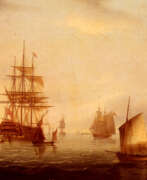

James Edward Buttersworth was an English painter who specialized in maritime art and is considered among the foremost ship portraitists in the United States of the nineteenth century. His paintings are particularly known for their meticulous detail, dramatic settings, and grace in movement.


Georges-Léon-Ernest Buysse is a Belgian impressionist and luminist painter. Busset took lessons from the Ghent painter Louis Titgadt. The artist Emil Klaus, who was one of his friends, also gave him a lot of advice. He has participated in exhibitions since 1894. At the 1894 Salon of the National Society of Fine Arts in Paris, he exhibited two canvases on the theme of "snow effects". At that time, his work was focused on landscapes, views of the city of Ghent and gardens of country residences in the vicinity of Ghent. In 1904, Busset was one of the co-founders of the artistic circle Vie et Lumière. His early work was realistic or pre-impressionist. Later, his palette became - under the influence of Emile Claus and after their trip to the south of France - clearer, the work acquired impressionist and luminist features. He adhered to Luminism, in particular as a co-founder of the art circle Vie et Lumière, and used light and lighting effects in his painting.


Jacques François Joseph Carabain was a Dutch-Belgian painter, known primarily for his scenes of cities and buildings in the Romantic-Realist style. He was especially interested in Medieval and Baroque structures, and was often attracted to busy market places.


John Wilson Carmichael was a British marine painter.
His name first appears as an exhibitor in 1838, when he contributed an oil painting, Shipping in the Bay of Naples, to the Society of British Artists. He showed both oil paintings and watercolours at the Royal Academy.
His painting of the bombardment of Sveaborg, which he witnessed during this assignment, was exhibited at the Royal Academy and is now in the collection of the National Maritime Museum.


Martin Léonce Chabry is a French painter. Thanks to his contacts and his recognized qualities, Chabry left for Paris as a resident of the City of Bordeaux and in 1854, he entered the studio of Constant Troyon. For two years, Chabry made frequent visits to Barbizon. In 1855, in Barbizon, Chabry met a Belgian-Dutch artist, Willem Roelofs, who invited him to visit Flanders. Following this advice, he settled for some time in Bruges, then visited Brussels in 1856. At that time he often worked with Verwee and Hippolyte Boulenger, in Tervuren, near Brussels. If Chabry can be considered as one of the fathers of the School of Tervueren, thanks will never be given to him in Belgium, "too French", curiously, he suffers in France from being too Belgian. In 1862, he moved to Sauternes, but continued to participate in the annual Brussels fair as well as that of Bordeaux. In 1867, the Bordeaux museum bought his first canvas, followed two years later by the King of the Belgians, Leopold II. In 1881, he undertook a long trip to Egypt, Palestine, Syria. At the end of June 1882, a personal exhibition of his trip to the East opens in Brussels.
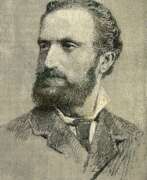

Guglielmo Ciardi was an Italian marine and landscape painter.
Ciardi graduated from the Venice Academy of Fine Arts, traveled extensively throughout the country and made sketches. These include views of the Venetian lagoon with fishing boats and the countryside around Treviso, mountain landscapes painted during his many trips to the cities of Veneto, Trentino and Lombardy.
Guglielmo Ciardi was an active participant in many exhibitions and was awarded a gold medal at the San Francisco Exposition in 1915.
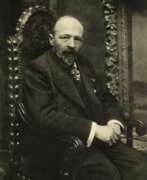

Franciscus Eduardus Maria (Franz) Courtens (1854–1943) was a Belgian painter. He was a leading figure in the Dendermonde School, famous for his paintings of nature and landscapes. Courtens was professor at the Royal Academy of Fine Arts (NHISKA) in Antwerp from 1904 till 1924. He was a personal friend of Leopold II, who gave him the privilege of free access to the royal Parc of Laeken. Some of his paintings stil remain in the Royal collection.


Alfred James Daplyn was an English-born Australian artist. Daplyn migrated to Melbourne in 1881, later becoming secretary of the New South Wales Art Society when he moved to Sydney. The Society's instructor in painting 1885-92, Daplyn influenced Charles Conder, Sydney Long and Julian Ashton.
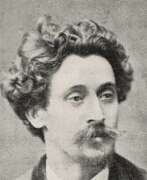

Louis Victor Antonio Artan de Saint-Martin was a Belgian marine painter. His work was influenced by the Barbizon School and the French marine painter Eugène Boudin. A convinced realist, he confined himself to the familiar North Sea, which he studied every day. He was fascinated by dramatic effects and exceptional atmospheric conditions. Just as in the paintings of the Tervuren school, his painting, created by the use of large quantities of pigment applied in copious layers or large masses skilfully distributed and then worked with a trowel, gives the work an appearance of breadth and immediacy.
Saint-Martin was one of the sixteen co-founders of the Société Libre des Beaux-Arts, an association opposed to the stylistic hegemony of the academies and salons. After 1880 he worked in a more impressionist style, and in 1881 he became a Chevalier de l'Ordre de Léopold. Two years later, the artist was awarded a gold medal at the International Colonial and Export Exhibition in Amsterdam.


Edmond De Schampheleer was a Belgian landscape painter and engraver. After completing his studies with Eugène-François de Block in Antwerp, he set himself up as a landscape painter; taking a realistic approach, derived from Théodore Fourmois and the French artists of the Barbizon School. He also combined plein aire techniques with large-scale painting in his studio. His style increasingly came to resemble that of the 17th century Dutch artists.


Jean-Joseph Delvin was a Belgian painter who specialized in scenes with animals (primarily horses). He attended the Royal Academy of Fine Arts in Ghent, where he studied under Théodore-Joseph Canneel, and worked in the studios of Jean Portaels in Brussels. Later, he undertook study trips to France and Spain. For many years, he shared a small workshop in a garden shed with Gustave Den Duyts. In 1883, he was invited to join the secessionist group Les XX, but he resigned only a few years later in 1886. He was also a member of La Libre Esthétique and Kunst van Heden (Art for Today) in Antwerp. At about that time, he began teaching at the Academy in Ghent and later became its Director (1902–1913). Among his many well-known students there were Albert Baertsoen, Gustave De Smet, Frans Masereel, George Minne and Frits Van den Berghe.


Karl Edvard Diriks was a Norwegian painter.
He is known for his naturalist outdoor paintings of clouds, rain squalls, snow flurry, storms and rough seas. He is represented with thirteen works in the National Gallery of Norway, in a number of other Norwegian galleries, and in galleries in France and Germany. He was decorated Knight, First Class of the Order of St. Olav, and Officer of the French Legion of Honour in 1920.


Pieter Cornelis Dommersen, born as Dommershuisen, was a Dutch painter and watercolourist active in England.
He was the elder brother of the painter Cornelis Christiaan Dommersen. His son William Raymond Dommersen (Dommerson) (1859-1927) also became a fine art artist in England, all three Dommersens painting the same genre of paintings. Pieter Cornelis specialist in sea-, land- and river-scapes.
Works of Dommersen are present in many museums such as Amsterdam, The Hague, Rotterdam, Utrecht and many museums in the United Kingdom.


Thomas Goldsworthy Dutton was a British marine artist and draughtsman.
Dutton is one of the most famous and prolific marine artists and shipbuilding lithographers of the Victorian era, and today the National Maritime Museum in Greenwich holds an almost complete collection of his published lithographs. He produced engravings from his own sketches as well as those of his contemporaries. These include views of warships, yachts and sailing races, steamships, clippers and sea battles. The artist's works are known for their accuracy and attention to detail.
Of particular value in our time is Dutton's book Yachting, which is a set of 12 hand-colored plates commissioned by wealthy shipowners and shipbuilders of the time. Each plate is accompanied by a descriptive text.


Richard Hermann Eschke was a German marine and landscape painter.
Richard Eschke became known as a pupil of his father Hermann Eschke and the Berlin Academy. Eschke lived in England for several years, where he made studies for a number of paintings.
Richard Eschke was awarded the small gold medal of the Berlin Art Exhibition.


Hermann Wilhelm Benjamin Eschke was a German painter of the second half of the 19th century. He is known as a marine painter.
Hermann Eschke began his career by traveling through southern France and the Pyrenees, after which he became a free-lance artist, creating sketches and designs while traveling in Europe. In collaboration with his son Richard Eschke, the master created murals and dioramas, including works for the Imperial Panorama in Berlin. His contribution to art was recognized with honors and medals, including the title of "Royal Professor" and the gold medal of the Berlin Artists' Association.


Henri-Jacques-Edouard Evenepoel was a Belgian artist whose most important works are associated with Fauvism. The artist debuted a portrait of his cousin (Louise in Mourning) at the 1894 Salon des Artistes Français. He showed four portraits at the Salon du Champ-de-Mars in 1895 and continued to exhibit there until his death. His first solo exhibition came at the Brussels Cercle Artistique (December 1897 – January 1898). Family and friends were the artist's preferred subjects; his full-length portraits, often against a neutral background, show the influence of Édouard Manet and James Abbott McNeill Whistler. His Parisian scenes were influenced by Henri de Toulouse-Lautrec and Jean-Louis Forain. Though his early scenes had a somber palette, his paintings while in Algeria (where he first wintered during his solo exhibition) were very different in style, anticipating the bold colours of Fauvism (e.g., Orange Market, Blidah).


Alfred William (Willy) Finch was a ceramist and painter in the pointillist and Neo-Impressionist style. Born in Brussels to British parents, he spent most of his creative life in Finland. In 1883 he became a founding member of Les XX, a group of twenty Belgian painters, designers and sculptors, who rebelled against the prevailing artistic standards and outmoded academism. He was impressed by the works of Georges Seurat and Paul Signac and changed his own painting style from a more realistic approach into a pointillistic style. In the following years, Finch became one of the leading representatives of his style in Belgium, along with Théo van Rysselberghe. During the early 1890s Finch switched careers from painting to pottery, upon the realization that he couldn't make a living by painting. In 1897, invited by count Louis Sparre, Finch moved to Porvoo, Finland, to head the Iris ceramics factory, and influenced the development of the local Jugendstil. After the factory was closed, Finch resumed his painting career.


William Teulon Blandford Fletcher is a British artist and one of the early members of the influential Newlyn School of Artists. He joined the Lyfe class at the Royal Academy of Charles Wehrle in Antwerp.
Blandford Fletcher travelled and worked as an itinerant artist until settling in Dorking in 1904 and then in Abingdon-on-Thames in 1915. Fletcher's best known work is Evicted (painted in Steventon in 1887), the first painting acquired by the Queensland Art Gallery in 1896.


Poppe Folkerts was a German marine painter, draughtsman and graphic artist. He studied at the Berlin Academy of Fine Arts under Karl Salzmann. In 1907 and 1908 he studied figure and portrait painting in Düsseldorf with Eduard von Gebhardt, before going to Paris in 1909, where he was accepted at the Académie Julian.
Poppe Volkerts is considered one of the most outstanding artists of the Frisian coast. As an enthusiastic sailor, he was able to capture the peculiarities of this landscape, the struggle of people with the forces of nature and the fascination of the sea with its constantly changing weather conditions and moods, with a unique liveliness and intensity. His pastose application of paint, special lighting and pure colours create the spatial depth and radiance inherent in the paintings.


Karl Gatermann the Elder was a German painter and graphic artist. He was the uncle of artist Karl Gatermann, who is typically called "Karl Gatermann the Younger" to distinguish between the two. In 1910 he received the First Prize for Painting of the City of Munich for the oil painting Life. From 1919 to 1942 he lived and worked in Lübeck. In Berlin in 1923 and 1925, he exhibited his watercolors in the galleries of Rudolf Wiltschek and in the Kunsthaus Heumann in Hamburg in 1926. Gatermann's watercolors were also shown in England and in the London Times. Gatermann predominantly focused on north German landscapes and cities, though he also painted still life and figurative scenes, and portraits of people.
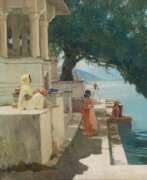



Johan Conrad Greive was a 19th-century Dutch painter. He was a member of Arti et Amicitiae from 1863, where he became chairman for three years. He is known for his paintings, lithographs, and topographical drawings in various sketchbooks, many of Amsterdam subjects. He created genre works, artist portraits, landscapes, and marines. Johan Conrad Greive's work has been offered at auction multiple times.


Carlos (Carl) Conrad Grethe was a Uruguayan-born German painter and academician. Grethe was born in Montevideo, Uruguay, but lived in Hamburg from the age of five. He studied at the Fine Arts School of Paul Düyffcke at the Karlsruher Kunstakademie, as well as the Parisian Académie Julian from 1884 to 1886. He interrupted his studies for almost a year to undertake a sea voyage to Mexico in 1888 and 1889. From 1894, Grethe was a member of the Munich Secession, and was also involved in the founding of the Karlsruher Künstlerbundes in 1896, the Stuttgarter Künstlerbundes, (the State Academy of Fine Arts in Stuttgart) in 1901, and the Verein Württembergischer Kunstfreunde. By the turn of the century Grethe had become prominent in representations of man and the sea, as well as of coasts and ports. His artistic style developed from a commitment to modern realism at the beginning of his career to a rather more impressionistic style in his later works.


Hermann Grobe was a German maritime painter.
He studied at the Munich and Düsseldorf Art Academies. His favorite subject for Grobe was the sea and everything connected with it. He painted a lot of pictures with ships on the pier and everyday scenes on the shore, sailors on the shore and fishing boats.


Jean Antoine Théodore Gudin was a French marine painter and court painter to both king Louis Philippe and subsequently Emperor of the French Napoleon III. Along with Louis-Philippe Crépin, he became one of the first two official Peintres de la Marine in 1830.




Johannes Friedrich Heinrich Hänsch was a German landscape painter and sculptor. Hänsch was born as the son of the sculptor Adolf Hänsch and his wife Johanna (nee Lehmann). He began his artistic training in his father's studio and initially continued it in the workshops of other sculptors before he decided to become a painter. On December 11, 1897, he began studying at the "Royal Academy of Fine Arts" in Berlin. As a freelance landscape painter, he was a member of the “Berlin Artists Association”. Since 1903, Hänsch has taken part in the Great Berlin Art Exhibition as well as in the exhibitions of the Association of Berlin Artists and in the Munich Glass Palace. His colorful painting showed a clear influence of Impressionism. He painted almost exclusively deserted landscapes from all parts of Germany. Paintings depicting human figures were a rare exception, but he did produce some mostly witty self-portraits.
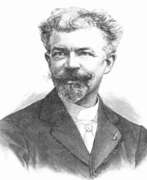

Georges Jean Marie Haquette was a prominent French painter, particularly known for his portrayals of fishermen and maritime scenes. Born in Paris, Haquette trained under notable 19th-century artists Aime Millet and Alexandre Cabanel, drawing influence from French Realist painters like Courbet. His unique focus was on the lives and labors of sea harvesters, differentiating his work from contemporaries who focused more on land-based peasants.
Haquette debuted at the Paris Salon in 1875 and continued to exhibit there, earning various recognitions including an honorable mention in 1878 and medals in 1880 and 1901. His notable works include "Un homme à la mer!" (1886), "La femme du matelot" (1887), and "La levée des filets" (1888). His painting "Net Fishers" was featured in "Famous Paintings of the World" (1894), emphasizing the picturesque and labor-intensive life of coastal peasants.
Many of Haquette's works are housed in prestigious museums, such as those in Brest, Dieppe, Mulhouse, Pontoise, and Rouen. Some of his notable paintings include "Le Manchon de Francine" in the Musée de Brou, "Pêcheurs" in the Musée du Vieux Château, and "Pêcheuse" in the Hôtel de Ville de Rouen.
For collectors, auctioneers, and art and antiques experts interested in Haquette’s work, his paintings represent an insightful view into 19th-century French maritime life and culture. His unique focus on sea harvesters adds a distinctive dimension to French Realist painting.
To stay updated on new product sales and auction events related to Georges Jean Marie Haquette, consider signing up for relevant updates. This subscription will keep you informed about important developments and opportunities in the world of Haquette’s art.
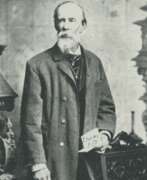

Edwin Hayes was an English and Irish marine painter, a member of the Royal Institution of Painters and Aquarists, and of the Royal Academy of Arts.
He studied art at the Dublin Society School of Art. A voyage across the Atlantic in his youth made an indelible impression on Hayes: his work invariably depicted ships and boats on the high seas. Over the course of his life, Hayes produced many seascapes, each with its own unique beauty.
His son Claude Hayes (1852-1922) was also a famous landscape and portrait painter.


Bernard Benedict Hemy is an English marine painter.
He was born in Australia, but his family soon returned to the United Kingdom, to Newcastle-upon-Tyne. Like his painter brothers, Bernard Hemy studied painting at the Newcastle School of Art. He specialized in depictions of the daily activities of fishermen, realistically documenting fishing scenes, coastal and harbor views, ships and sailing boats.


Franz Carl Herpel was a German painter of the last quarter of the nineteenth and first third of the twentieth centuries. He is known as a marine painter.
Herpel was born in Voronezh in the Russian Empire and returned to Germany with his family. He graduated from the Königsberg Academy of Arts and his works were regularly exhibited in Munich, Hanover, Dresden and other German cities. At the end of the XIX century the artist was invited to Turkey and worked in Constantinople, fulfilling the orders of the Turkish sultan. He was an active member of the German Yacht Club and traveled extensively on his personal yacht, which was reflected in his nautical works.


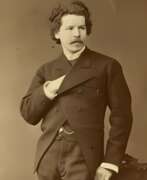

Oskar Georg Adolf Hoffmann (Russian: Оскар Адольфович Гофман) was a German painter known for his tranquil and detailed landscape paintings. Born in 1851, Hoffmann specialized in capturing the serene beauty of nature, often depicting forest scenes, rivers, and pastoral settings with remarkable precision.
Hoffmann’s work is distinguished by its meticulous attention to detail and a deep appreciation for the natural world. His paintings often feature lush greenery, reflective water bodies, and soft, diffused light, creating a sense of peacefulness and calm. Hoffmann's ability to portray the subtle nuances of light and shadow made his landscapes particularly captivating.
Some of Hoffmann’s notable works are displayed in various European museums and galleries, admired for their technical excellence and tranquil beauty. His pieces continue to attract collectors and art enthusiasts, drawn to his masterful representation of nature’s serenity.
For those interested in acquiring or learning more about Oskar Georg Adolf Hoffmann’s works, signing up for updates on new product sales and auction events is highly recommended.














